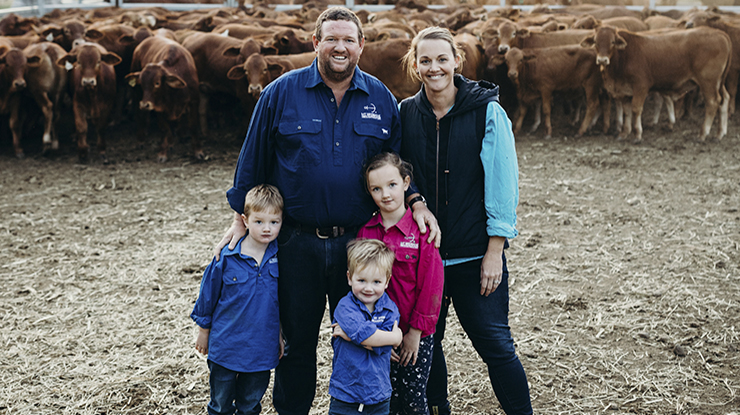Testing and timing for better weaning rates
05 December 2022
 Don and Andrea McConnel with children, Stirling, Digby and Audrey, in the main yards at ‘Mt Brisbane’ with weaners.
Don and Andrea McConnel with children, Stirling, Digby and Audrey, in the main yards at ‘Mt Brisbane’ with weaners.
Keeping joining short and sharp while maintaining a consistent pregnancy testing program are just two of the latest tactics Queensland producers the McConnels have put in place to keep weaning rates high in their Droughtmaster herd through the seasons.
Together with his mother Carli and wife Andrea, Don McConnel runs a commercial Droughtmaster herd alongside their stud business, Mt Brisbane Droughtmasters, on their property near Esk, Queensland.
To manage risks in their varied environment, the family is always looking for ways to maximise calf survival through to weaning. MLA’s Breeding EDGE workshop was one of the latest places where they picked up new strategies.
“We went to a Breeding EDGE workshop because you can always pick up handy little things at those courses,” Don said.
“Your business can be going really well, but there could be someone there with a different idea or approach that can help you.
“We knew that we had a slight issue occurring in our herd in the interval between pregnancy testing and weaning, so we were keen to figure out what was going on.”
Knowing the cause
For the McConnels, the workshop reinforced the importance of pregnancy testing as a tool to not only identify breeders that weren’t performing, but to also understand why this was the case.
“Pregnancy testing is so important,” Don said.
“We’re very fortunate that we have a very good vet who comes out to do our testing and if he spots a problem with a test, he’ll take a blood sample straightaway so we can get an answer on it.”
For example, the McConnels have been on the watch for hydatids, so doing pregnancy testing and then any blood testing needed has helped them check their herd status to ensure they’re healthy.
“We’re sitting on around a 91% pregnancy rate across the whole herd, and we cull any cows that are dry or who are losing calves between pregnancy testing and weaning so we can make sure our herd keeps performing.”
Joining time
Keeping joining within a short time frame is another method the McConnels use on Mt Brisbane to boost the reproductive efficiency of their herd, with the strategy paying dividends for productivity.
“We only give our replacement heifers an eight-week joining period,” Don said.
“We’ve found that by shortening that joining period up, we’ve gotten a far better pregnancy test rate – we’ve achieved a 95% pregnancy rate after those eight weeks.
“This is because our heifers only have eight weeks of calving and then they’ve finished calving a month or so before the bulls are even out.
“This gives them plenty of time to start cycling again so when the bulls go out, they’re ready to get straight back into calf.”
Moving with the times
Adjusting their joining date to reflect shifting seasons has also enabled the McConnels to maximise weaning rates within their herd.
“You’ve got to look at the nutritional requirements of cattle and adjust what you’re doing in line with how the seasons are going,” Don said.
“We usually aim to start calving in the middle of August, but we’ve stretched it a little bit further out because our green date has moved.
“We used to be able to count on having our first fall of rain in late August or September, but now we’re not getting our first decent rain until October – so we’ve pushed back that calving period to make sure they’ve got better nutrition during calving.
“Since we’ve been doing that, we’ve definitely been seeing better results at weaning time.”
Similarly, by bringing weaning forward, the family ensure their breeders can recover to peak condition ready for a successful next calving.
“We know that because our grasses are predominately summer grasses, once the frost hits, the nutritional value in our grasses disappears pretty quickly,” Don said.
“With this in mind, we’re trying to move the weaning forward earlier so when the cows are still drying off, they can access better feed and get condition back on them quicker.”
What’s next?
Always striving for constant improvement, the McConnels have already got their next few tricks up their sleeve to ensure maximum reproduction within their herd.
“With this year being a really wet year, a lot of the minerals have actually leached out of the soil – so we’ll be relying more on our supplements this year to keep our breeders in condition,” Don said.
“We’re also going to set up some of our yards so we can start getting much more data on our cattle using National Livestock Identification System (NLIS) tags.
“Using these tags, we’re going to follow all the calves right through their life and see which paddocks we should be putting them in for the best performance we can get.”


